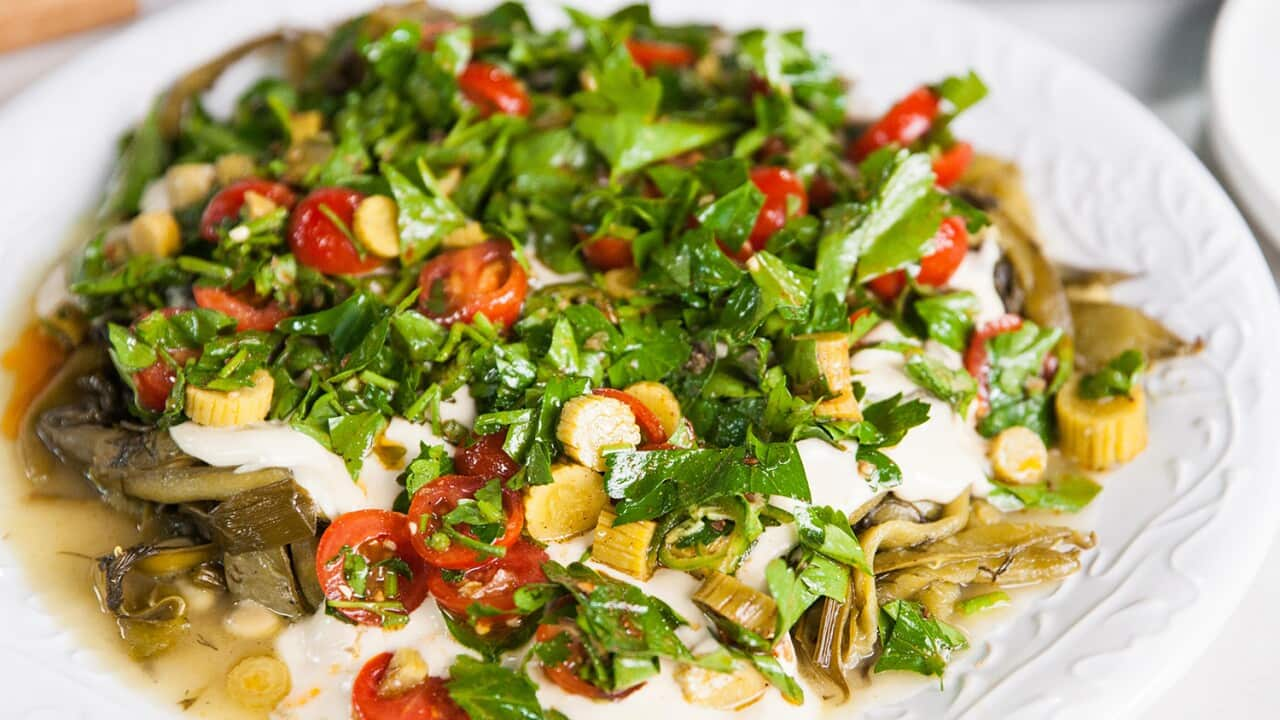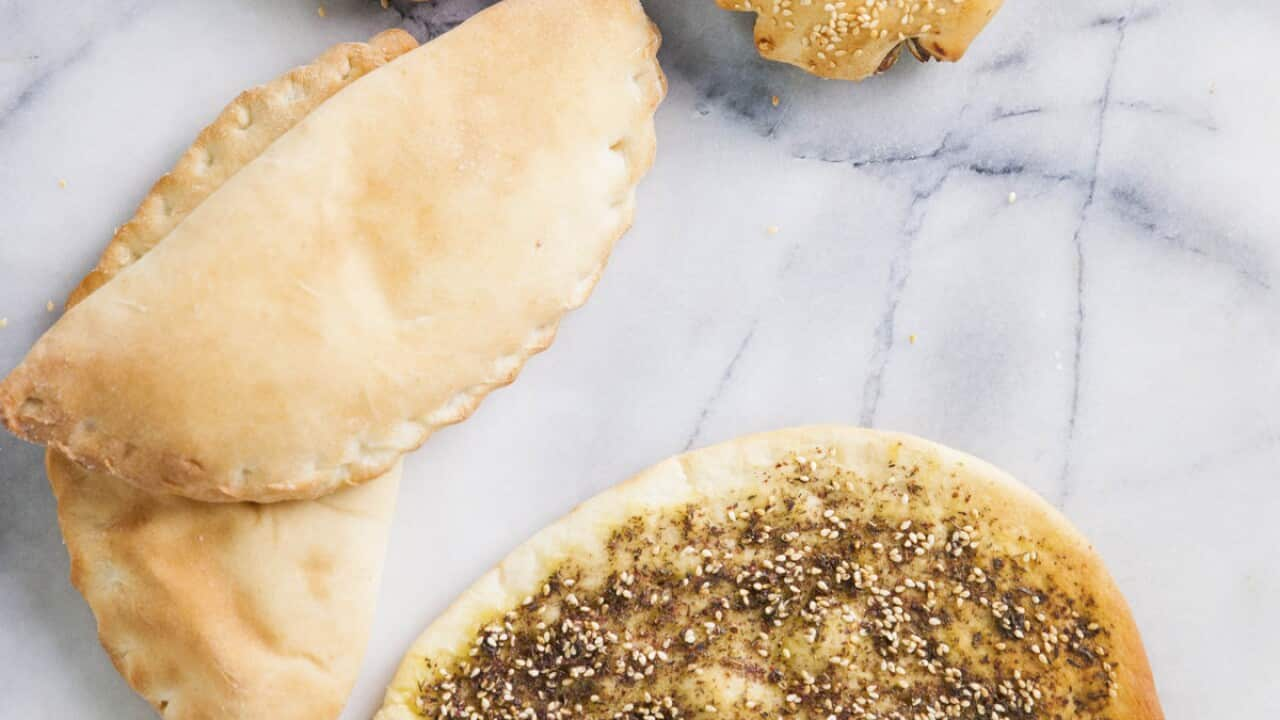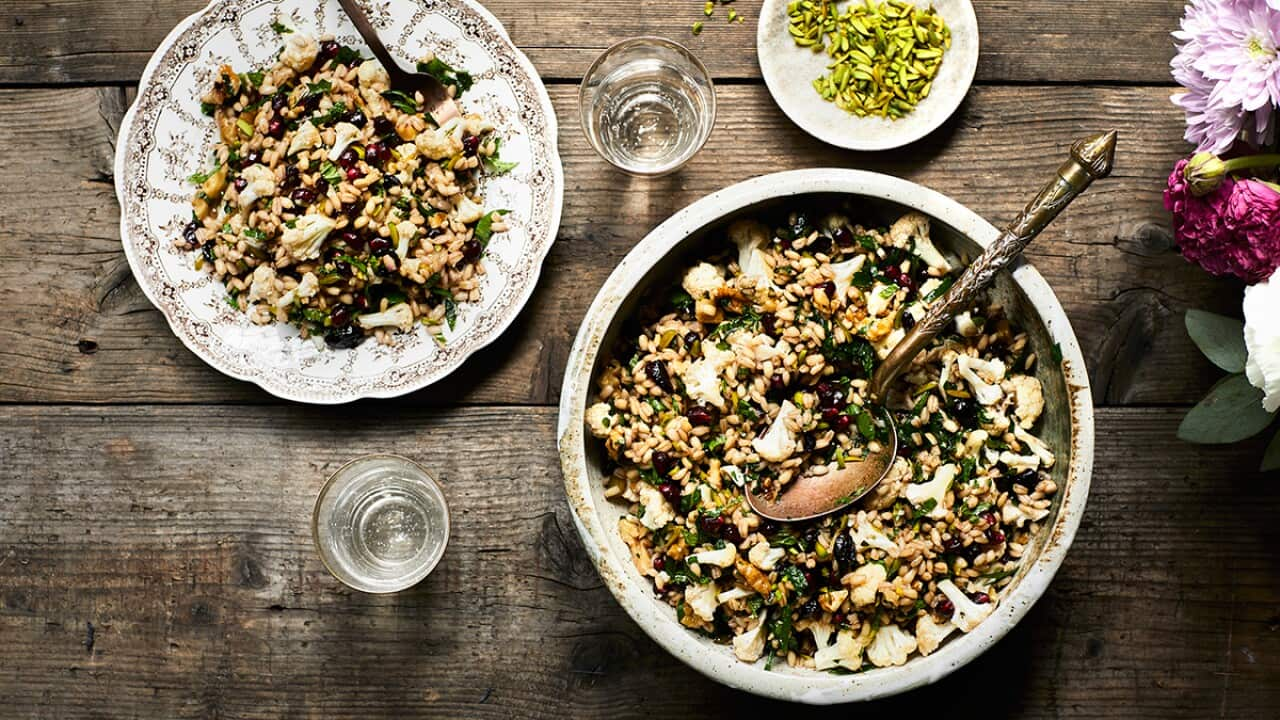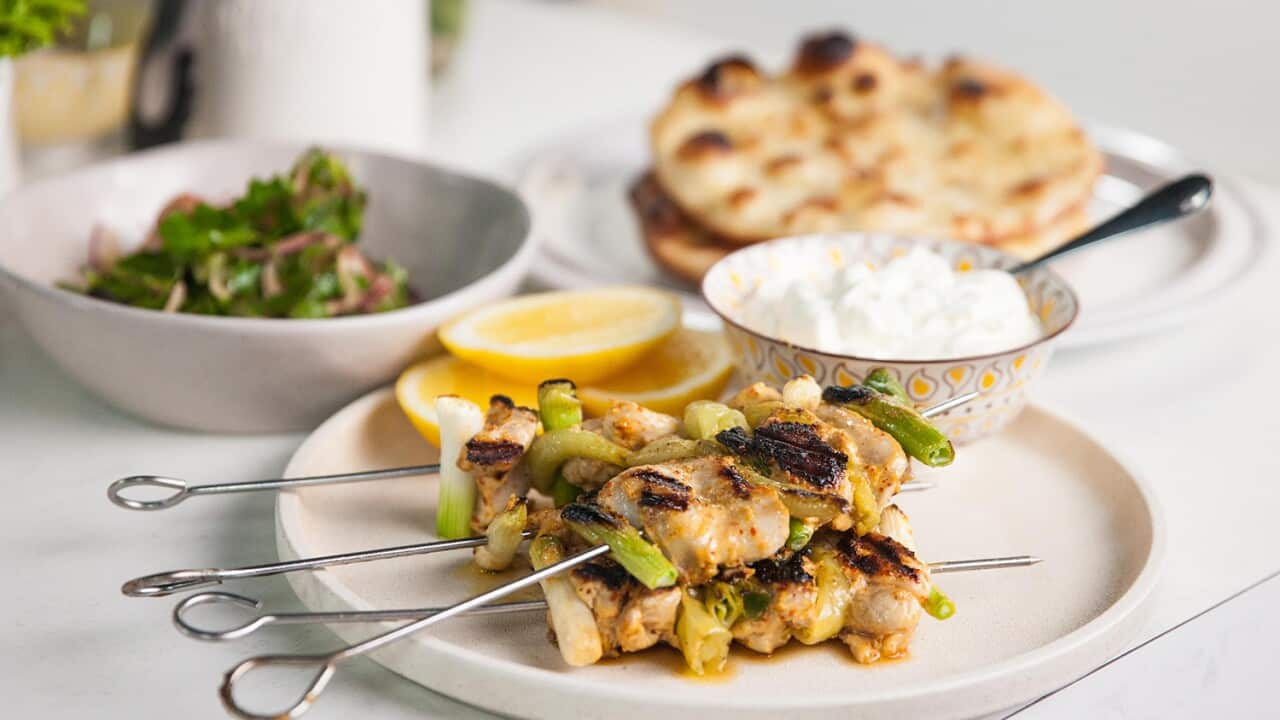--- Watch Shane Delia and friends showcase their favourite dishes from the Middle East in streaming free on SBS On Demand. ---
Dips are the hero of every party. They are quick and easily executed, and can be served with pretty much anything. One place that knows their dips like none other is the Middle East.
Across this region, it's common to wind down after the workday with a mezze consisting of small plates, salads and an abundance of dips. These condiments are also essential for any traditional and triumphant Middle Eastern feast. Whether it's a romantic dinner or a big family lunch, there's one for every occasion.
Broaden your dip repertoire and uncover the captivating history and flavours of these nine popular Middle Eastern dips.
Muhammara
Muhammara is a hearty walnut and roasted red pepper dip that originates from the Syrian city of Aleppo. The dip's name means "reddened" in Arabic, and it's not hard to see why. A classic muhammara's key ingredients include roasted red peppers, walnuts, breadcrumbs, pomegranate molasses, olive oil and Aleppo pepper.
The dip's name means 'reddened' in Arabic, and it's not hard to see why.
The pepper provides just enough spice to complement the dip's slightly sweet and smoky flavour, and the walnuts create a thick texture that makes it perfect for scooping. Muhammara is best enjoyed with simple accompaniments such as pita bread, fish or lamb.
MADE FRESH

Fresh muhammara
Baba ganoush
If hummus had a younger sibling, it would be baba ganoush. This silky, luxurious dip is basically tender eggplant blended up with garlic, olive oil, lemon juice, tahini and salt.
Across the Levant, eggplants are charred on a grill or baked in a wood-fired oven to impart a smoky flavour and sumptuous texture. Baba ganoush works well as an appetiser with manakeesh bread or makes a delicious side for roast meats.
MORE THAN A STARTER
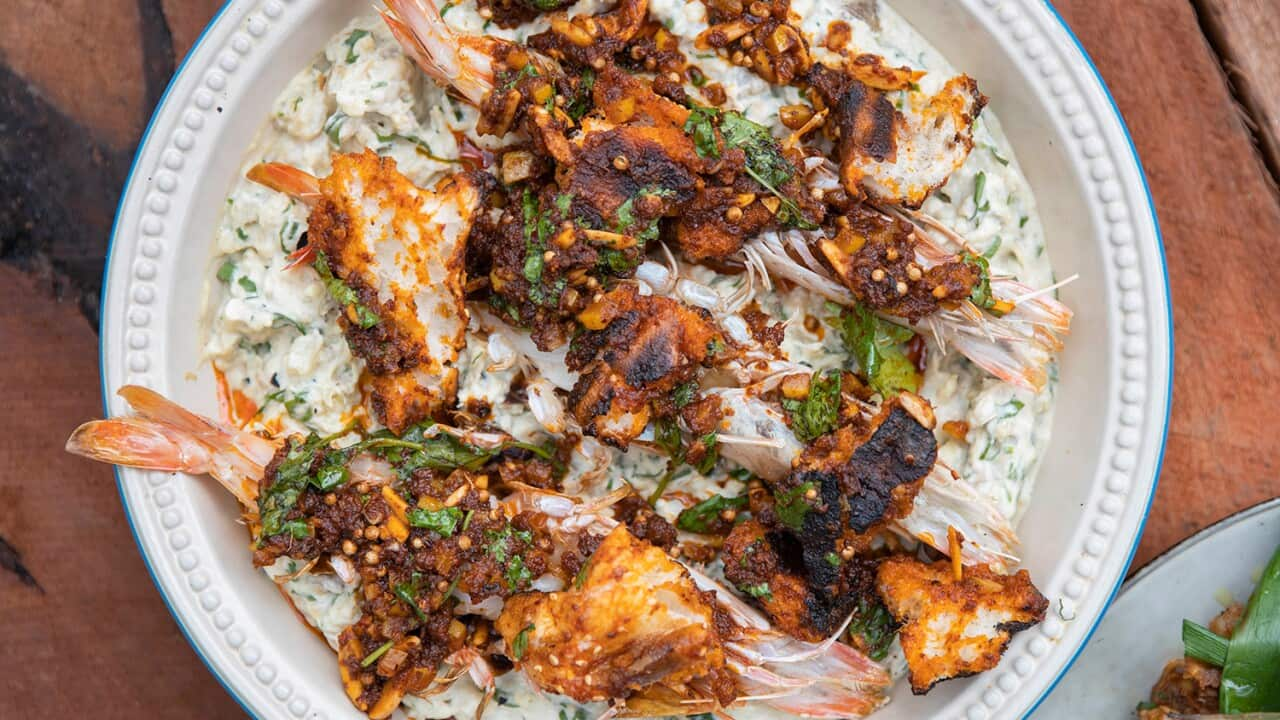
Ali Nazik barbecued king prawns with baba ganoush
Moutabel
Moutabel is baba ganoush's lesser-known cousin. They've both got that smoky eggplant flavour, but moutabel has an even creamier texture and richer profile.
Made the traditional way, roasted eggplants are pounded and mixed by hand in a large copper bowl with tahini, garlic, yoghurt and olive oil. The dip is then garnished with parsley, pomegranate seeds, walnuts or paprika and served with warm pita bread. Moutabel is eaten daily during the month of Ramadan, and you can also find it on any Middle Eastern mezze platter.
Ful medames
Swap out chickpeas for fava beans and you'll end up with ful medames, a traditional Egyptian breakfast that's also Egypt's national dish.
The stewed fava beans are mixed with lemon juice and cumin, then finished with a drizzle of olive oil and fresh herbs. A typical Middle Eastern platter is incomplete without ful medames. Use it as you would hummus and serve with whatever dippers you have on hand.
Toum
Think of toum as a Middle Eastern version of mayonnaise. This bold and creamy spread is a Lebanese staple made from garlic, olive oil, lemon juice, salt and a dash of water. It was traditionally made by grinding these ingredients using a mortar and pestle, but can now be whipped up at lightning speed in a food processor.
A DIP WITH BITE

How to make toum (Lebanese garlic dip) at home
The garlic releases emulsifiers, which stabilise the sauce and stop the oil and water from splitting (like eggs in mayonnaise). Toum is commonly eaten with shawarma, kebabs and other grilled meats. It can also be spread over baked potatoes or used as a dressing for any pita.
Havuc
Toum is a key ingredient for this next colourful and classic Turkish dip. Made with shredded carrots, toum and Greek yogurt, havuc is easy to prepare and easier to enjoy. The carrots provide a natural sweetness, which complements the tanginess of the Greek yogurt, and makes it stand out from other yogurt-based mezze plates. Serve it with warm pita bread or as a side dish for grilled meat or fish.

Havuc is a simple and rich Turkish dip made with shredded carrot, garlic toum and Greek yoghurt. Perfect served with warm pita bread. Source: Andrew Dorn
Labneh
In Levant, having good labneh in the fridge is as non-negotiable as is it to have good hummus. This creamy and tart dip can be thought of as a Middle Eastern-style, yoghurt-like cheese.
Making labneh is simple. Just combine yoghurt with salt, strain it and let time do the hard work. After 12 to 24 hours, you'll be left with a thick, spreadable cheese that can be slathered on sandwiches or chips. Eat it the traditional way by spreading it in a bowl with a pool of olive oil, sprinkling it with za'atar, and serving it with a side of pita bread.
Khyar bi laban
Khyar bi laban is considered both a salad and a dip and can be found on nearly every Middle Eastern table. Made with only five fresh ingredients, this tzatziki twin is a cool and creamy dish or sauce. It traditionally features strained goat's milk yoghurt, since it has a richer taste and is combined with cucumbers, garlic, salt and mint. Serve khyar bi laban with other dips as part of a mezze or use it as a condiment for gyros and grilled meats.
Techina or tahini
A typical Middle Eastern platter would be incomplete without techina or tahini dip. This simple, tangy and flavoursome condiment is made from a base of toasted and ground sesame seeds, which are then thinned with lemon juice and water. You can also add garlic to brighten the dip and garnish it with chopped parsley. Techina is incredibly versatile and can be scooped up with flatbread and sliced vegetables or used as a dressing to accompany meat and vegetable dishes.
You can also add garlic to brighten the dip and garnish it with chopped parsley. Techina is incredibly versatile and can be scooped up with flatbread and sliced vegetables or used as a dressing to accompany meat and vegetable dishes.

You'll always want a jar of this tahini sauce on hand. Source: Camellia Aebischer
A GO TO

How to make tahini sauce
We would never suggest giving up your hummus, but we highly recommend giving these nine delicious dips a try. Like many Middle Eastern recipes, techniques and ingredients vary according to region and preference. Grab yourself some pita and prepare to discover a world of flavours.
A MIDDLE EAST FEAST

Katmer (Gaziantep pistachio pastry)

